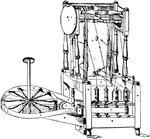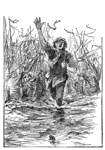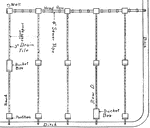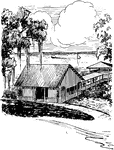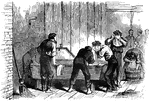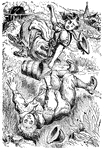
Jack and Jill
Jack and Jill went up the hill to fetch a pail of water. Jack fell down and broke his crown, and Jill…

Jack and Jill
Jack and Jill went up the hill to fetch a pail of water. Jack fell down and broke his crown, and Jill…

Columbus, Kentucky
"General view of Columbus, Ky., and its fortications, looking down the river, showing the 'Iron Bluffs'…

Paducah, Kentucky
"View of the town of Paducah, Ky., at the confluence of the rivers Ohio and Tennessee, the Northern…

Thoroughfare Gap
"Thoroughfare Gap, Va., a pass in the mountains on the Manassas Gap Railroad, near Strasburg, held by…
Fort Clinch
"Interior view of Fort Clinch, on Amelia Island, Fla., commanding the Harbor of Fernandina, captured…

Common Seal
"The ground-color of the hair or skin, when this animal is alive and dry, is pale whitish-gray, with…

Sea Bear
"It is the size of a large bear; girth at the sholder, five feet, near the tail, twenty inches; fur…
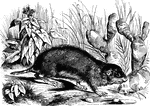
Brazilian Ctenomys
"Is reddish above and white beneath; body six inches long, and tail two inches. It lives near water,…
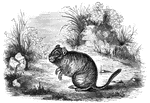
Octodon
"In size and shape, it resembles the water rat. The fur is long and moderately soft; upper parts of…

Shannon
"Firing on the schooner Shannon, laden with ice, from the battery on Morris Island, Charleston…

Mortar Battery Stanton
"Interior of the Mortar Battery Stanton, Tybee Island, Ga., showing the operation of 13-inch mortars…
Fort Taylor
"Fort Taylor, Key West, Fla. Key West, the most western of the Pine Islands, is about sixty miles southwest…
Fort Vulcan
"Fort Vulcan, Jones's Island, Savannah River, Ga.- one of the Federal batteries cutting off communication…

Mahaska Crew
"The crew of the United States gunboat Mahaska, Captain Foxhall A. Parker destroying the water…

Confederate rams
"Confederate rams from Charleston Harbor attacking the Federal blockading squadron, January 31st, 1863.…

Advance upon Charleston
"The advance upon Charleston, S. C.- pioneer movement- landing of the One Hundredth New York Volunteers…

Harrison Mansion
"The old Harrison Mansion, Harrison's Landing, Va., the birthplace of President William Henry Harrison,…

Cutting Levees
"Cutting the levees near the state line of Louisiana and Arkansas, twenty miles above Lake Providence,…

Red River
"The war on the Red River. Admiral Porter's fleet passing through Colonel Bailey's Dam, above Alexandria,…
War in Texas
"The War in Texas. Brownsville, occupied by the army under Major General N. P. Banks, in 1863. The sudden…

Savannah, Georgia, Looking East
"View of Savannah, Ga., looking east, toward Fort Jackson. Savannah, the entry port of Georgia, is built…

Dutch Gap Canal
"Blowing out of the bulkhead of the Dutch Gap Canal, James River, Va., January 1st, 1865. At twelve…
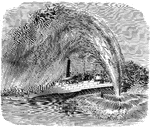
Commodore Barney
"The war in Virginia. Explosion of a torpedo under the Commodore Barney, on James River, August…
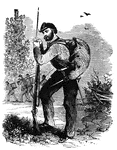
Water Skin
"Water skin and mode of carrying. Hints to Soldiers in the camp and on campaign."— Frank Leslie, 1896

Weehawken
"The ironclad Weehawken returning to fire a parting shot at Fort Sumter, after the bombardment,…
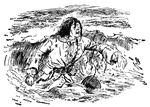
Author shipwrecked
The Author gives some Account of imself and Family- His First Inducements to travel- He is Shipwrecked,…

Radish
View of a radish, illustrating the root-hairs, which absorb most of the water the plant needs.
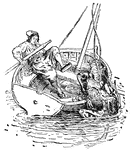
Frog on board
As Gulliver rows in the miniature boat made for him by the Queen of Brobdingnag, a giant frog leaps…

Millen Prison Pen
"The Prison Pen at Millen, Ga., as it appeared previous to the arrival of General Sherman's Army. Our…

Fort Walker
"Landing of United States troops at Fort Walker, after the bombardment, November 7th, 1861. In order…

Fort Pulaski
"The bombardment of Fort Pulaski, second day, Friday, April 11th, 1862. General Quincy A. Gilmore took…
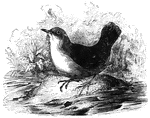
Black Dipper
The black dipper, also known as the European water-ousel, feeds on small shellfish and insects.

Nests of the genus Euplectes
Woven of grass, the nests of the genus Euplectes have an opening which faces down towards the water.…
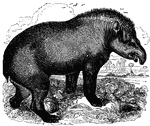
Tapir
"It is a large animal, measuring six feet in length, and is of a uniform brown color. It inhabits the…
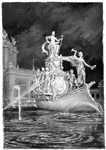
World's Fair
"The World's Fair at Chicago. Central portion of MacMonnies Fountain- effect of electric light."—E.…
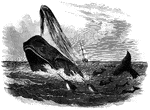
Sperm Whale
A sperm whale breaching up through the water. Its color is blackish above and white below.

River Bateau
A river bateau. Bateaux were rudely constructed of logs and planks, broad and without a keel. They had…

Arnold's Battle
Scene of Arnold's naval battle. This sketch was made from the pilot's room of the steam-boat just after…

Arnold Wounded
Place where Arnold was wounded. This view is in a narrow alley near the north end of Sault au Matelot…
Cascades
The Cascades, on St. Ann's Rapids. These rapids are so called from the cirumstance that a village of…
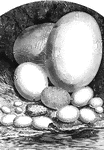
Comparative view of the size of the eggs of different animals
1, Epyornis; 2, Ostrich; 3, Cassoway; 4, Wild Goose; 5, hen; 6, Pigeon; 7, Humming-bird; 8, Eagle; 9,…

Grallatores
A group of Grallatores, an order with characteristically long legs, well suited for wading in shallow…
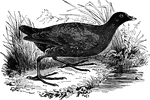
Moorhen
Also known as the waterhen, the moorhen lives around rivers and lakes, feeding on worms, insects, mollusca,…

Common European Water Rail
The common European water-rail is native to warmer parts of Europe, as well as portions of Asia.
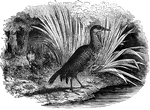
Weka
"Seventeen inches long; color brown; it flies badly, but runs with great swiftness; never takes to the…

Natatores
A group of birds of the order natatores, whose webbed feet are well adapted for propelling them on and…
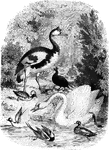
Group of Water Fowl
A group of water-fowl at a bank, with a fountain and pond visible in the background.
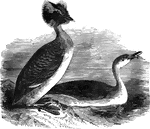
Sclavonian Grebe
Also known as the horned grebe, dipper, water-witch, and hell-diver, the sclavonian grebe is common…
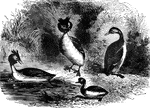
Grebes
Expert swimmers, grebes hunt fish, frogs, crustaceans, and insects in both salt and fresh water.
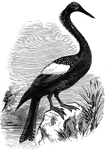
Anhinga
Also known as the snake-bird, the anhinga inhabits the freshwater areas of the South Atlantic States;…
